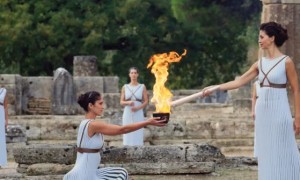South Korean divers swam though dark, cold waters into a sunken ferry on Wednesday, feeling for children's bodies with their hands in a maze of cabins, corridors and upturned decks as they searched for hundreds of missing.
The divers, with oxygen and communications lines trailing, can only see a few inches in front of them in the wreckage of the ship that started sinking a week ago after a sharp turn. Most of the victims were high school children, who were told to stay where they were for their own safety and were trapped.
Most of the bodies found in the last two days had broken fingers, presumably from the children frantically trying to climb the walls or floors to escape in their last moments, media said.
"We are trained for hostile environments, but it's hard to be brave when we meet bodies in dark water," diver Hwang Dae-sik told Reuters, as the funerals of 25 students were held near the capital, Seoul.
Prosecutors investigating the disaster raided the home of Yoo Byung-un, the head of a family that owns the Chonghaejin Marine Co. Ltd, the company that operated the Sewol ferry. They also raided his son's home and the office of a church with which Yoo has been associated, said a prosecutor who did not want to be identified.
The finances of Chonghaejin and its complex share structure have come into the spotlight in recent days. Yoo was jailed for fraud for four years in the early 1990s.
But it was not immediately clear how big a development this was. Korean police and prosecutors often make dramatic raids to show that progress is being made in a high-profile case.
Underwater, at the site of the sunken Sewol, divers are able to work for nearly an hour at a time as long as the oxygen lines do not snag on sharp corners of the ship's internal structure. When they use cumbersome oxygen tanks on their backs instead, they can work for about 20 minutes before an alarm bell sounds.
The Sewol sank last Wednesday on a routine trip from theportofIncheon, nearSeoul, to the southernislandofJeju.
Of the 476 passengers and crew on board, 339 were children and teachers on a high school outing. only 174 people have been rescued and the remainder are presumed to have drowned.
The confirmed death toll on Wednesday was 146, many found at the back of the ship on the fourth deck.
Hwang said his team had retrieved 14 bodies so far. "We have to touch everything with our hands. This is the most grueling and heartbreaking job of my career," he said.
Captain Lee Joon-seok, 69, and other crew members have been arrested on negligence charges. Lee was also charged with undertaking an "excessive change of course without slowing down".
LAW REQUIRES CAPTAIN TO STAY ON BOARD
Several crew members, including the captain, left the ferry as it was sinking, witnesses have said, after passengers were told to stay in their cabins, even though it was time for breakfast. President Park Geun-hye said on Monday that instruction was tantamount to an "act of murder".
"The charged crew members appear to have not carried out their duty to rescue the passengers at all," prosecutor Ahn Sang-don told a briefing. "based on the fact that they were gathered in the bridge, engine room and so on, then left the boat, we believe negligent homicide is applicable."
According to Article 10 of Seafarers' Act, a captain has to remain on board until all passengers have disembarked.
A boy with a shaking voice gave the first distress call to the emergency services when the ferry listed.
Most of those who survived made it out on deck and jumped into rescue boats, but many of the children did not leave their cabins, not questioning their elders as is customary in hierarchical Korean society. They paid for their obedience with their lives.
Lee was not on the bridge when the ship turned. Navigation was in the hands of a 26-year old third mate who was in charge for the first time on that part of the journey, according to crew members.
The wife of one crew member under investigation who did not wish to be identified quoted her husband as saying: "I should have died out there."
"He told me that he was taking some rest as he had finished his shift. He fell from his bed and struggled to open the room door to get out. He said he didn't go to the steering house to meet up with rest of the crew. Rather he was found by coastguards and was rescued.
"My husband didn't get along with other crewmen, but he told me that Captain Lee was someone comfortable and extremely calm. He said Captain Lee was like no other: he didn't drink much, although he did smoke."
星期三(4月23日),韩国潜水员穿梭在迷宫般的船舱、走廊和上翘的甲板之间,在冰冷漆黑的水中用他们的手去搜索数百名遇难者的尸体。
一周前,在沉船之后,潜水员带着氧气补给和通讯设备,在能见度只有几英寸的失事客轮里展开搜救。大部分遇难者是高中生,他们被告知为安全起见呆在原地,因而被困。
过去两天发现的大多数尸体的手指是抓破了的,大概是孩子们在最后时刻疯狂地试图爬上墙壁或地板逃生而抓破的,媒体说。
在首尔附近举行的25名学生的葬礼上,潜水员Hwang Dae-sik 告诉路透社记者“我们受过训练,专门在恶劣环境中工作,但当我们在漆黑的水下碰到尸体时,很难保持勇敢。”
调查此起事故的检察官突击搜查“岁月号”所属的Chonghaejin船舶管理公司所有者Yoo Byeong-eon的住所。他们也搜查了他儿子的住所和与Yoo有关的教堂办公室,一名不愿透露姓名的检察官说道。
最近几天,chonghaejin的资产及其复杂的股权结构状况备受关注。90年代初,Yoo因欺诈罪被囚禁了4年。
但目前还不知道该调查进展如何。韩国警方和检察官常常发起惊心动魄的突击检查,来表明案件调查正在高调进行。
在岁月号沉没的地方,只要氧气袋不被船内部结构的尖角钩破,潜水员每次差不多可以工作一个小时。但如果换成笨重的氧气罐的话,他们工作20分钟后,警钟就响了。
上周三(4月16日),从首尔附近的京畿道安山市前往济州岛修学旅行的岁月号客轮沉没。
船上有476名的乘客和船员,其中339人是一个高中学校的老师和学生,他们要前往济州岛修学旅行。目前,只有174人获救,其余人估计都已经淹死。"
星期三,经过确认的死亡人数达146人,许多人死在第四层甲板的船背上。
Hwang说他的团队到目前为止已经打捞出14具尸体。“我们要用双手去搜索一切。这是我职业生涯中最艰苦和最让我心痛的工作,”他说。
69岁的船长Lee Joon-seok,还有其他船员由于玩忽职守已经被捕。李还被控告“在不减速的情况下而急剧转向”。
法律要求船长留在船上
包括船长在内的几个船员,在船下沉时弃船而逃,有目击者说,虽然当时是吃早饭的时候,但他们也告诉乘客们要呆在客舱里。本周一(4月21日),韩国总统朴槿惠说,该指令无异于谋杀。
“被指控的船员显然根本没尽他们救援乘客的责任,”检察官 Ahn Sang-don 在发布会上说。”基于他们聚集在船桥上,发动机室里和其它地方,然后逃跑的事实,我们认为过失杀人是成立的。”
根据海员法第10条规定,船长必须在所有的乘客都上岸后才能离开船。
当客轮倾斜时,一个男孩用颤抖的声音给紧急服务中心打了第一个求救电话。
大多数幸存者是从甲板跳进救生艇,但许多孩子没有离开客舱,他们没有向长辈提出质疑,这是韩国等级社会里常见的情况。他们为了顺从而付出了生命的代价。
船翻的时候,Lee不在船桥上。根据船员所说,该客轮当时是由一个26岁的三副来驾驶的,这是她在此次航程中首次掌舵。
调查者中,一个不愿透露姓名的船员妻子引述她的丈夫话说:“我应该死在那里。”
“他告诉我,交接班后,那时他正在休息。他从床上滚下来,挣扎着打开房间的门后逃出。他说他没有去驾驶室与其它船员碰面。最后岸警卫队发现了他,他因此而获救。
“我的丈夫与其他船员并不和睦,但他告诉我李船长是个平易近人、沉着冷静的人。他说李船长和其他人不一样:虽然他也抽烟,但他喝酒不多。”







